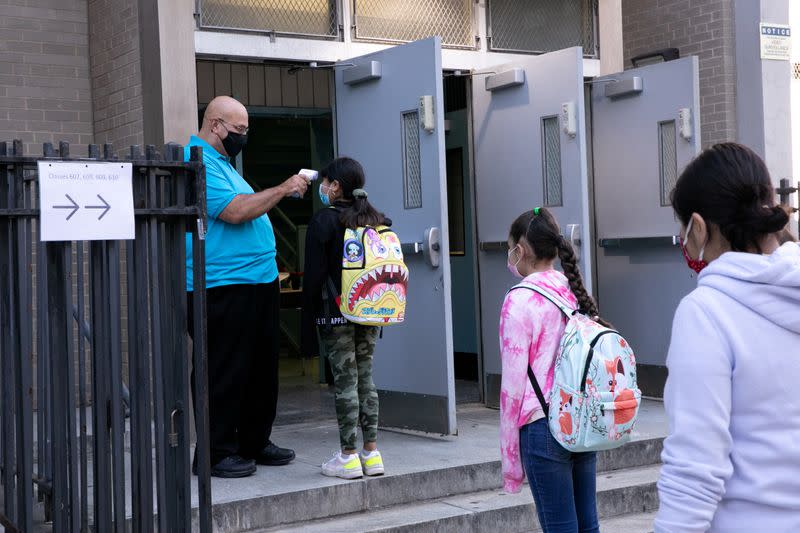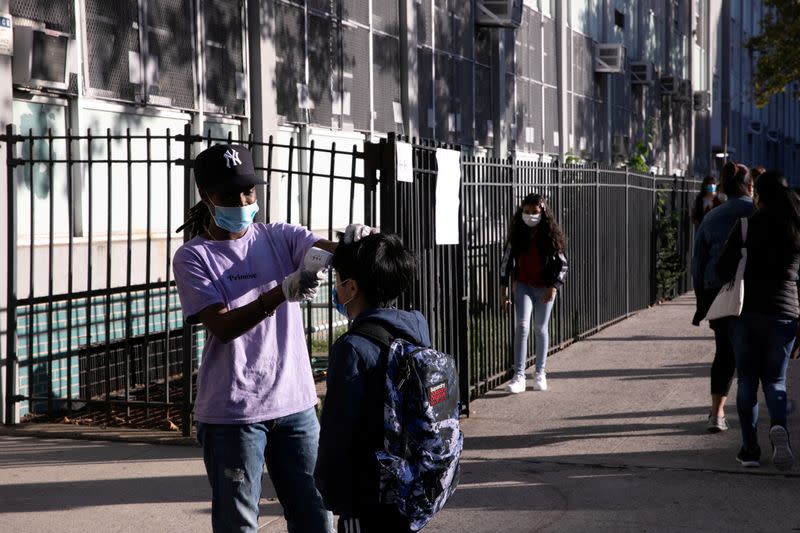U.S. schools in suburbs, small cities reopening without COVID spike; big cities up next
By Deena Beasley
(Reuters) - U.S. schools from kindergarten to high school have avoided a spike in COVID-19 cases, early data show, but medical experts say the real test is coming as students in large densely-populated cities such as New York and Miami return to classrooms.
The Centers for Disease Control and Prevention this week said more than 270,000 COVID-19 cases had been reported in children aged 5-17 since March. Cases in school-age children ticked slightly higher in mid-September as more schools reopened, but remains well below the peak set in mid-July.
Over 700 primary, middle and high schools that have at least partially reopened, reported that 0.07% of students and 0.14% of staff had a confirmed coronavirus infection in the first half of September, according to data collected by Brown University https://bit.ly/3kWpwnJ.
While the Brown sample is a fraction of the United States, and national statistics are scarce, a study by Switzerland's Insights for Education of 191 countries found reopening schools https://www.reuters.com/article/idUSL8N2GQ2UV is not linked to an increase in COVID-19 rates.
"There is starting to be some reassuring data that when you put in place the right measures - and have control of community spread ... you can open schools safely," said Dr. Nathaniel Beers, co-author of the American Academy of Pediatrics' school opening guidelines.
Tougher days may be ahead.
Attendance so far has been mostly voluntary and reopenings concentrated in suburbs and smaller cities. Medical experts said additional challenges for big cities include space constraints, older buildings with painted-shut windows, inadequate air circulation, little outdoor space and limited funding for efforts such as tracking down contacts of those infected.
The $2 trillion federal stimulus package passed in March included $13.2 billion for K-12 education, but progress on another bill has stalled.
"Many urban school districts are struggling," Beers said. "The COVID-19 virus has had a disproportionate impact on Black, brown and indigenous people as well as lower socioeconomic groups."
New York City, the largest public school district in the United States, this week began reopening https://www.reuters.com/article/idUSL1N2GQ0Q0 after two delays. Infections have spiked in some neighborhoods, though, and officials have said they could reverse course if that endures.
In response to criticism that poorer students were being hurt the most in the Los Angeles area, county elected officials this week agreed to consider reopening early grades for a limited number of schools and expressed caution.
"We have to remember that with every re-opening there is increased risk for COVID-19 transmission," the public health director, Barbara Ferrer, said in a statement.
Florida's Miami-Dade County, the fourth largest school district, plans to return students to classrooms on a staggered basis starting next week. The state required its public schools to reopen in August, but areas where the virus was too prevalent - such as Miami - were exempted.
Florida's September cases in school-age children fell over the month, as measured by seven-day averages of new cases, according to epidemiologist Jason Salemi at the University of South Florida. New case rates during the month were steady to down in elementary-age kids with more variation in middle and high school populations. They are down dramatically from mid-July. http://covid19florida.mystrikingly.com
"If you implement as many mitigation strategies as you can, I believe you can be relatively safe in bringing kids back to school," Salemi said.
The American Federation of Teachers union lost a lawsuit to delay Florida reopenings, but President Randi Weingarten said stricter adherence to virus mitigation measures lowered infections in August and September.
"The lessons are that masks work and physical distancing works ... But if you take your foot off the cautionary safeguards then woe is us," Weingarten said.
(Reporting by Deena Beasley, editing by Peter Henderson and Grant McCool)



